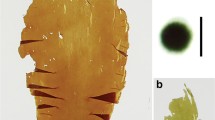Summary
The interrelationships between internal and external environment and the genesis of orange plants, and its bearing upon the phenomenon of phenotypic sex determination, have been investigated and in part elucidated in a new species ofBlastocladiella, B. Emersonnii. Spores from resistant sporangia yield populations which consist of over 98% colorless thin-walled plants and under 2% orange thin-walled plants. This ratio remains unaffected by most environmental factors such as quality of light, pH, and composition of various natural media. In the presence of certain concentrations of cycloheximide, however, the growth rate of the population is decreased toca. 10% of normal without loss of viability, at which point the % orange plants may be increased from less than 2% to as much asca. 25%. By following the developmental sequence which culminates in discharge of swarmers among the thalli in such populations, a third category of plants, thin-walled and color-less but appearing long after other plants have discharged, was discovered. Swarmers from orange thalli are incapable of fusions, either among themselves or with those from ordinary colorless or late colorless plants. Swarmers from the three different classes of plants, however, exhibit striking differences in behavior. Swarmers from orange plants are 4–5×6–7 μ and, if water is provided, swim about erratically and rapidly for prolonged periods.Ca. 99% are incapable of germination, but about 1% are consistently viable on a yeast-starch medium, and plants in the population derived from them are exceedingly, variable in their growth rates. The proportion of 2nd. generation orange plants among such populations is inversely related to the % viability of the swarmers derived from the parent orange plant. Swarmers from late colorless plants are usually viable on the yeast-starch medium, and all plants among the population derived from them are extraordinarily constant in their growth rates. On bicarbonate media, the proportion of 2nd. generation orange plants is directly related to the viability of the swarmers derived from the parental late colorless plant; but, at the very best, it is much lower than that for populations derived from either R. S. or orange plants. Finally, swarmers from ordinary colorless plants, usually 7×9 μ, are also generally viable. The plants among the population derived from them are by no means as variable in their growth rates as those from orange plants, but are seldom as constant as those from late colorless plants. The proportion of orange plants in such populations bears no relation to viability of swarmers but is, like that for late colorless plants, generally very low. Finally, when R.S. derived from swarmers of ordinary colorless plants are allowed to discharge, and the spores are transferred to yeast-starch medium, the proportion of orange plants in the new population is dependent upon the age of the original resistant sporangium. This is not true for R.S. which originate from swarmers of either orange or late colorless plants. The observations and conclusions are discussed in the light of a unified hypothesis for phenotypic sex determination, with which all the data are consistent.
Similar content being viewed by others
References
Barner, H. D. andCantino, E. C. 1953. Amer. J. Bot. (in press).
Cantino, E. C. 1951. Antonie van Leeuwenhoek.17, 59.
Cantino, E. C. 1953. Amer. Naturalist (in press).
Couch, J. N. 1941. Amer. J. Bot.28, 704.
Couch, J. N. andWhiffen, A. J. 1942. Amer. J. Bot.29, 582.
Emerson, R. 1941. Lloydia4, 77.
Emerson, R. 1950. Ann. Rev. Microbiol.4, 169.
Emerson, R. andCantino, E. C. 1948. Amer. J. Bot.35, 157.
Emerson, R. andWilson, C. M. 1949. Science110, 86.
Harder, R. undSörgel, G. 1938. Nachrichten Gesell. Wiss. Göttingen. Math.-phys. Kl., N.F., Fachgruppe VI (Biol.).3, 119.
Hatch, W. R. 1933. J. Elisha Mitchel Sci. Soc.49, 163.
Hatch, W. R. 1935. Ann. Bot.49, 623.
Hatch, W. R. andJones, R. C. 1944. Mycologia36, 369.
Kniep, H. 1929. Ber. Deutsch Bot. Ges.47, 199.
Matthews, V. D. 1937. J. Elisha Mitchell Sci. Soc.53, 191.
Sörgel, G. 1937. Z. Bot.31, 401.
Sparrow, Jr. F. K. 1943. Aquatic Phycomycetes. University of Michigan Press. Ann. Arbor.
Stüben, H. 1939. Arch. wiss. Bot.30, 353.
Whiffen, A. J. 1952. Mycologia43, 635.
Wilson, C. M. 1952. Bull. Torrey Bot. Club79, 139.
Author information
Authors and Affiliations
Rights and permissions
About this article
Cite this article
Cantino, E.C., Hyatt, M.T. Phenotypic “sex” determination in the life history of a new species ofBlastocladiella, B. Emersonii . Antonie van Leeuwenhoek 19, 25–70 (1953). https://doi.org/10.1007/BF02594831
Received:
Issue Date:
DOI: https://doi.org/10.1007/BF02594831




